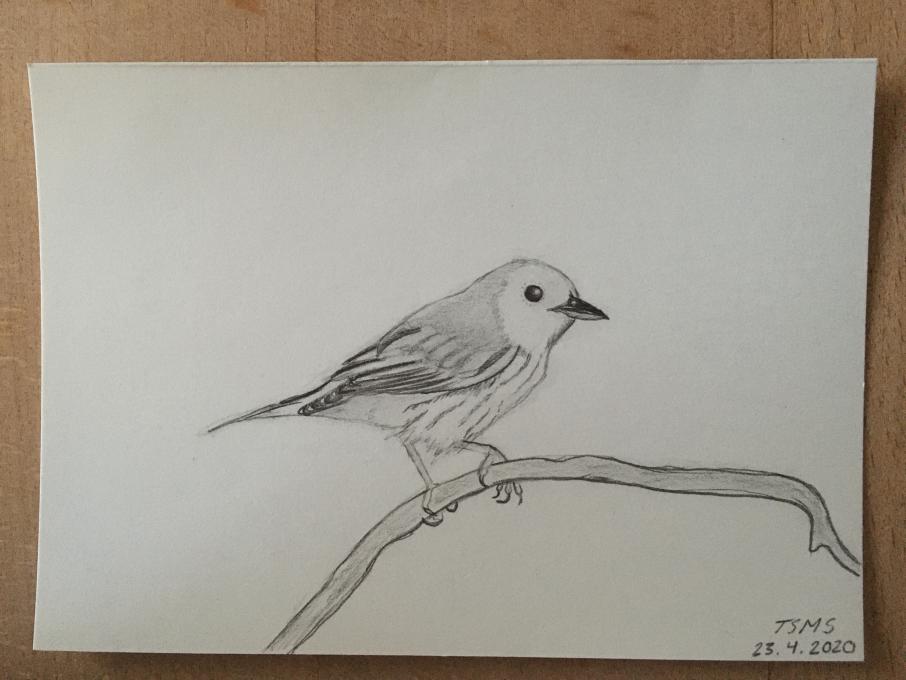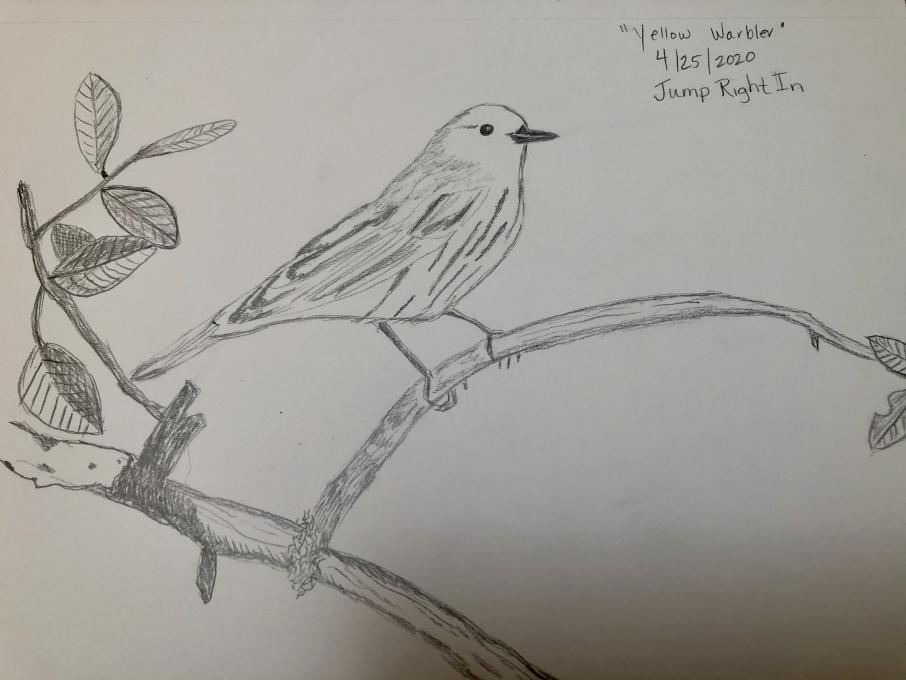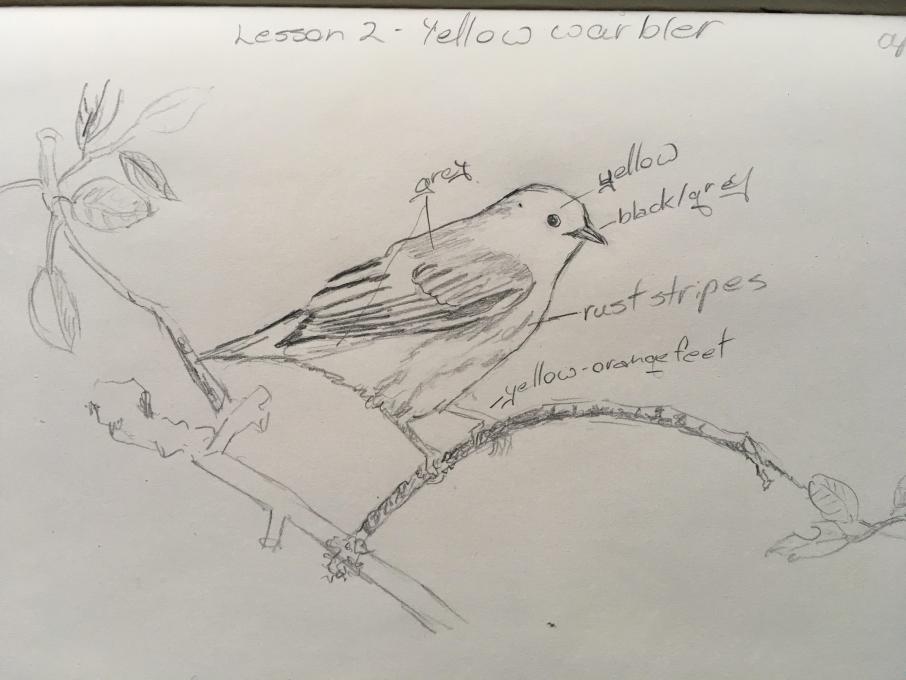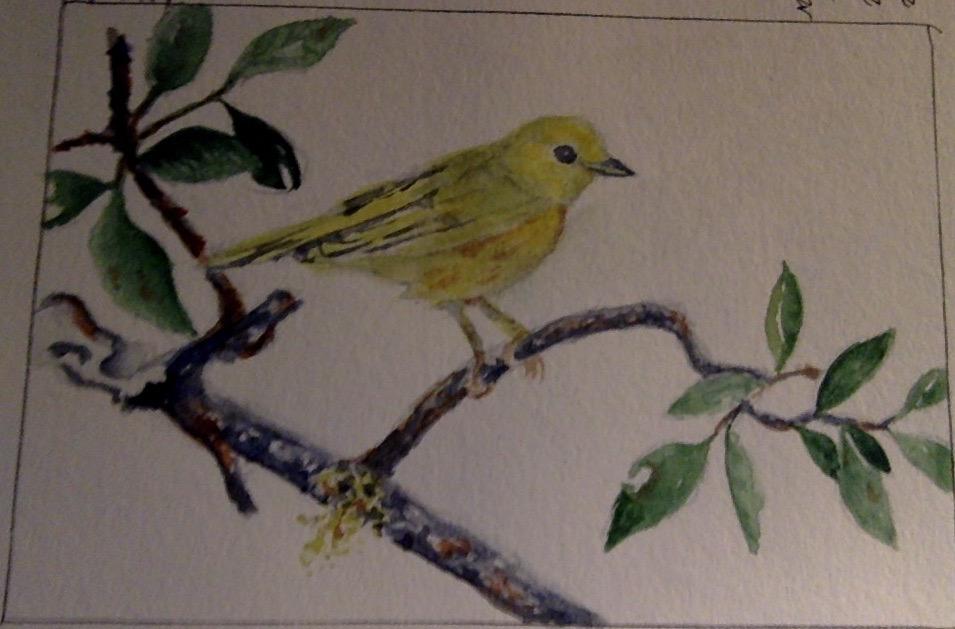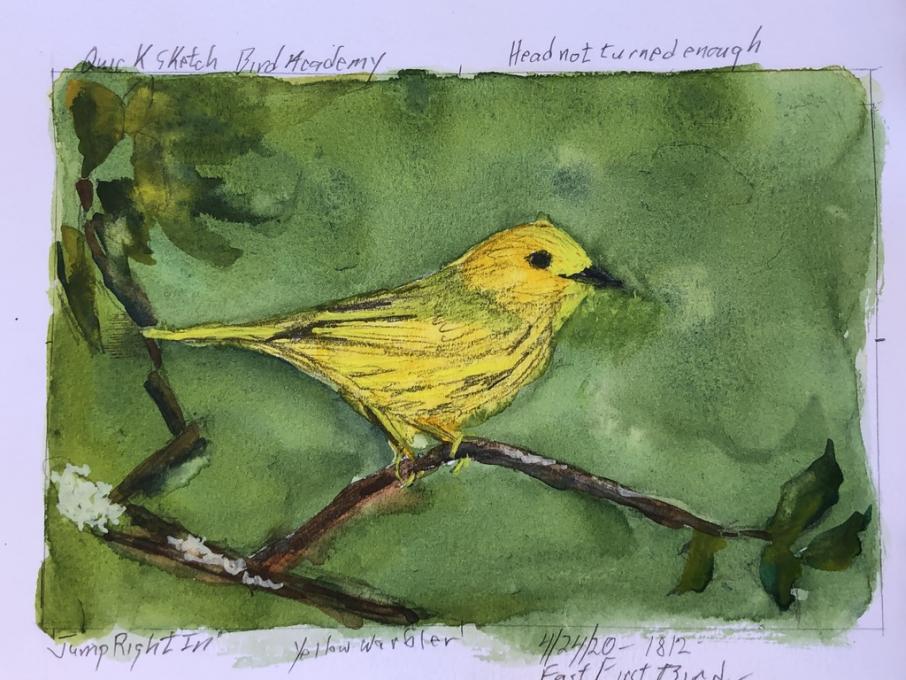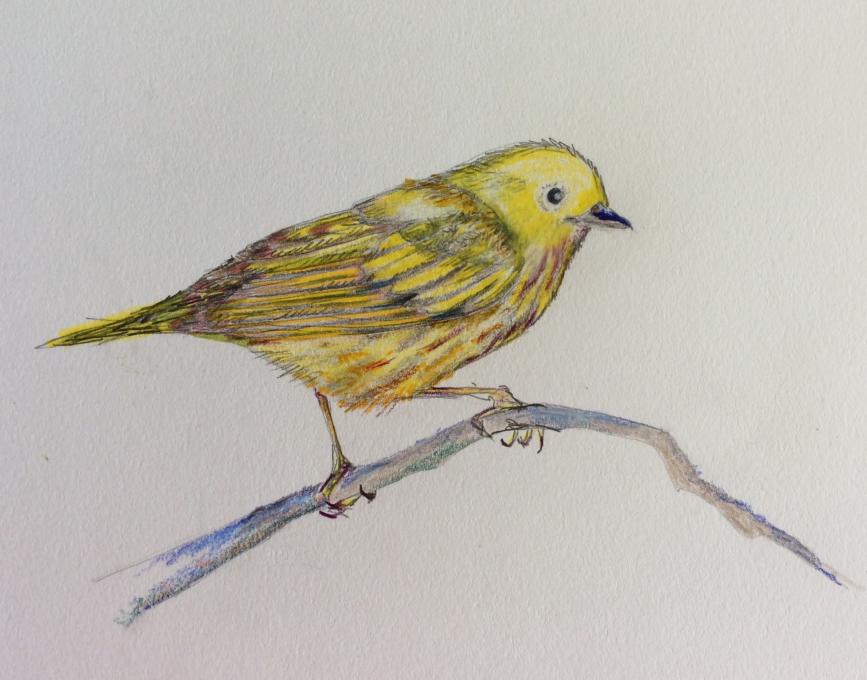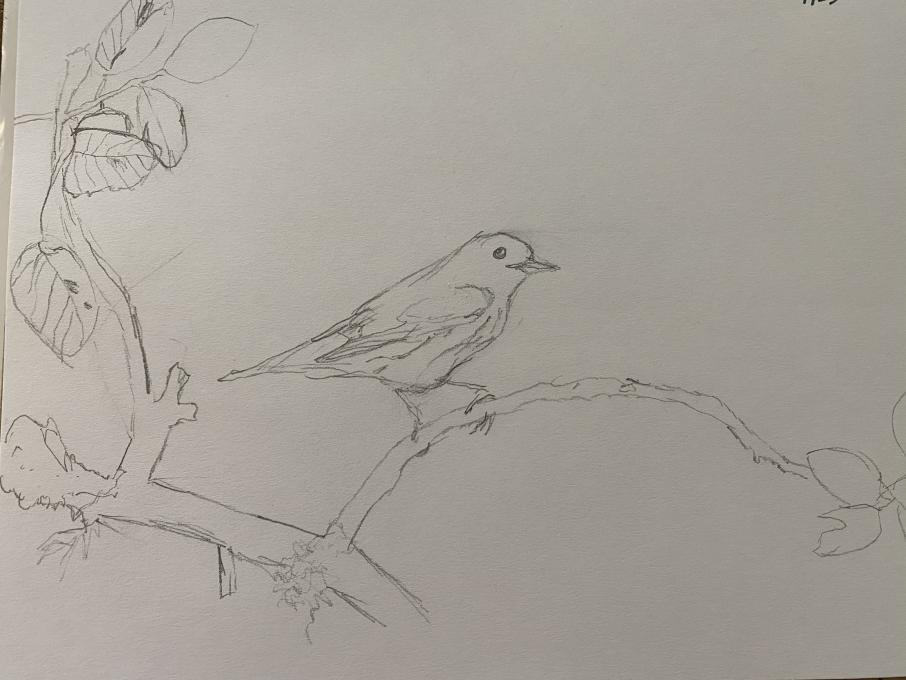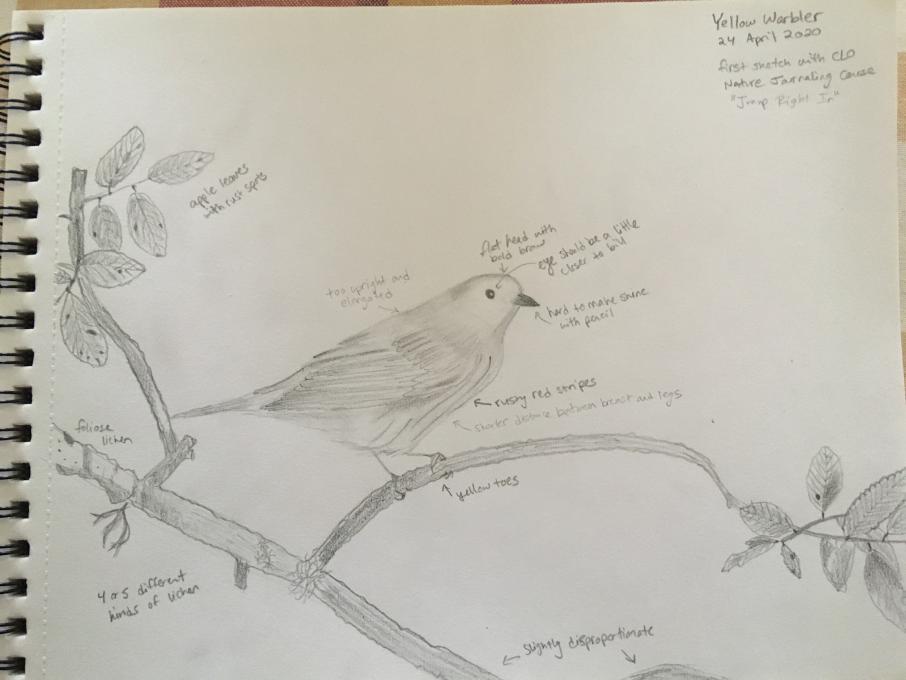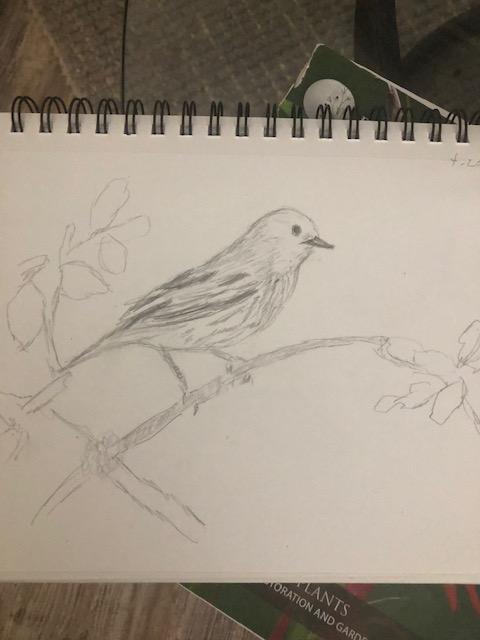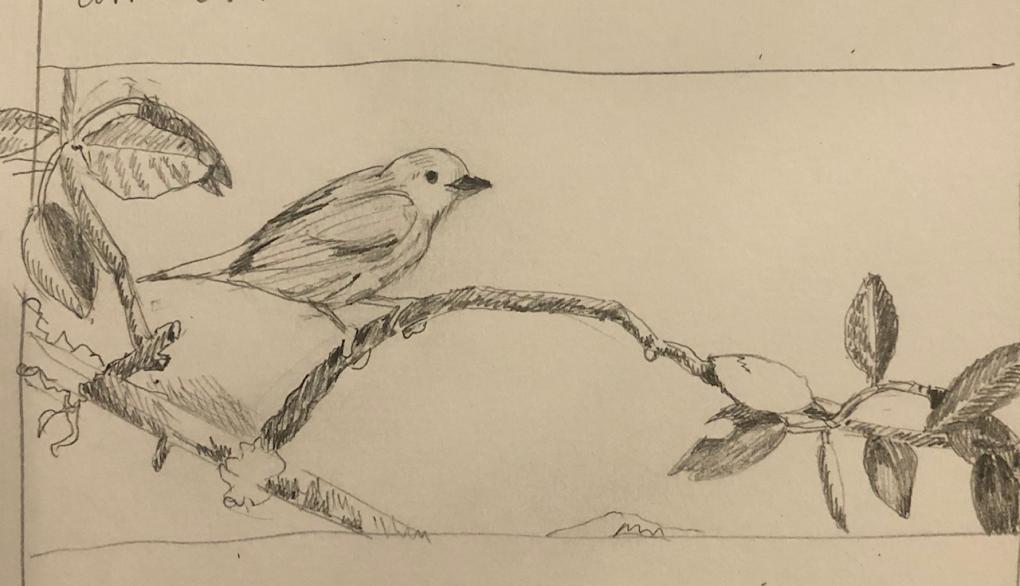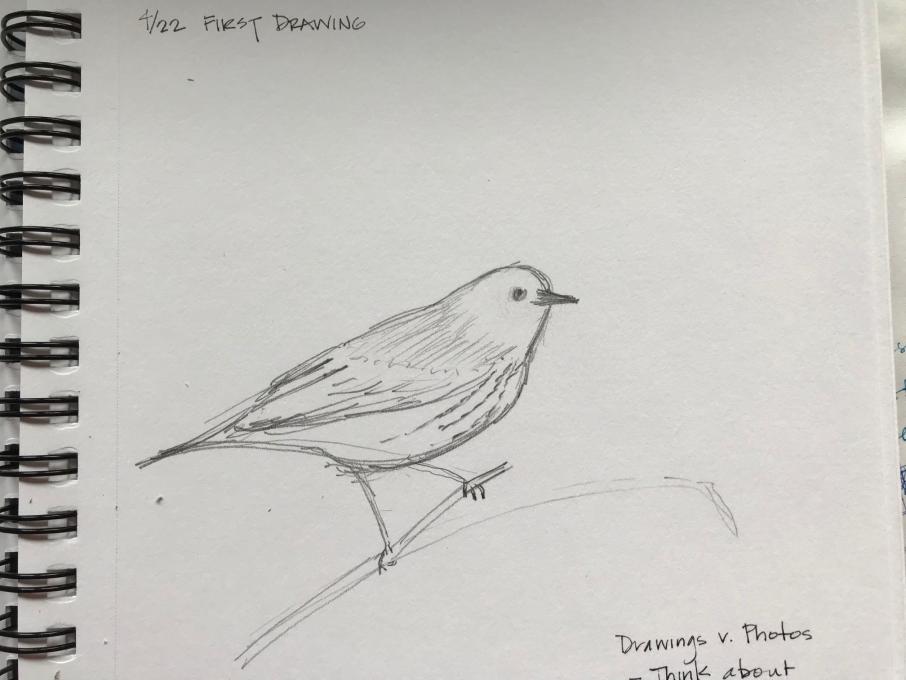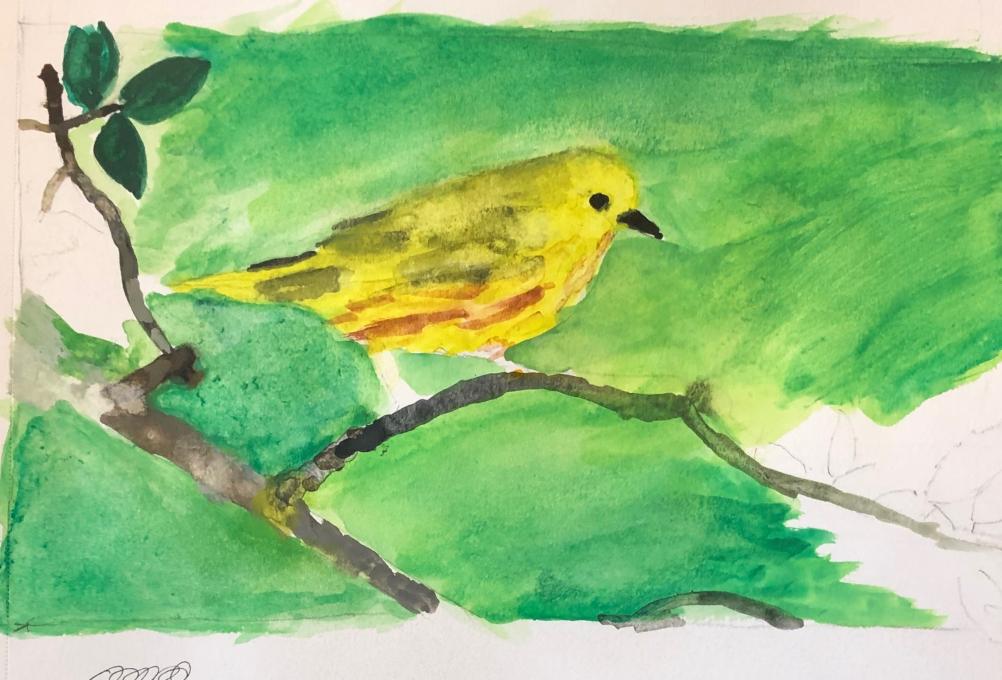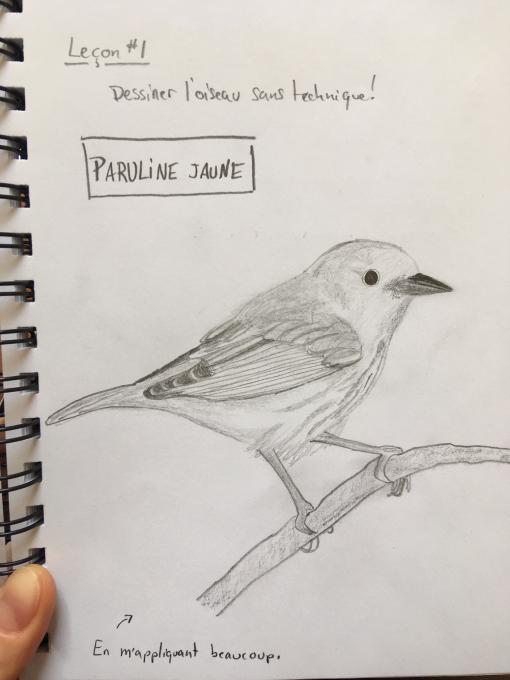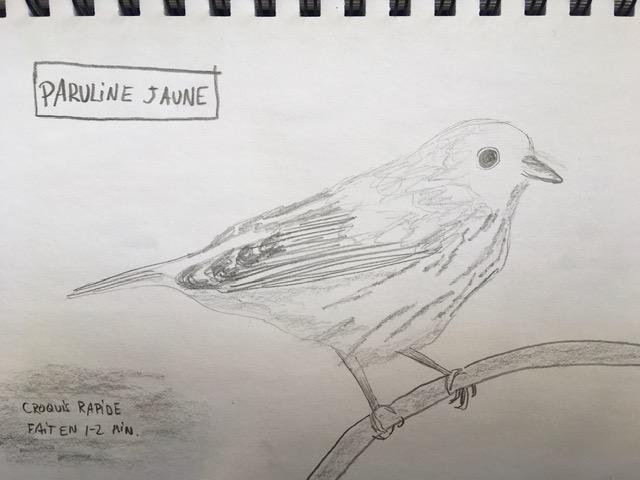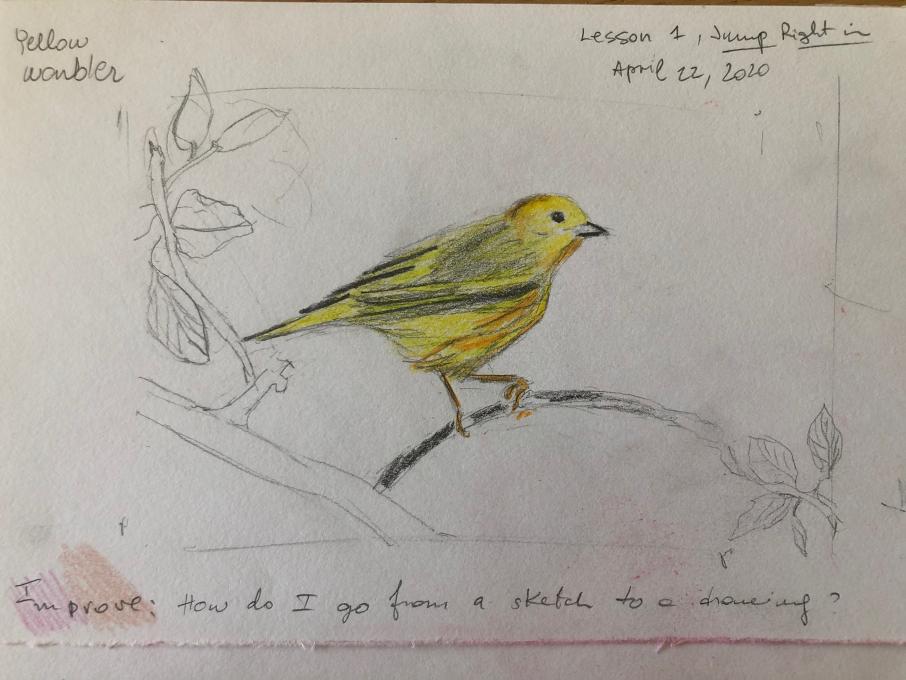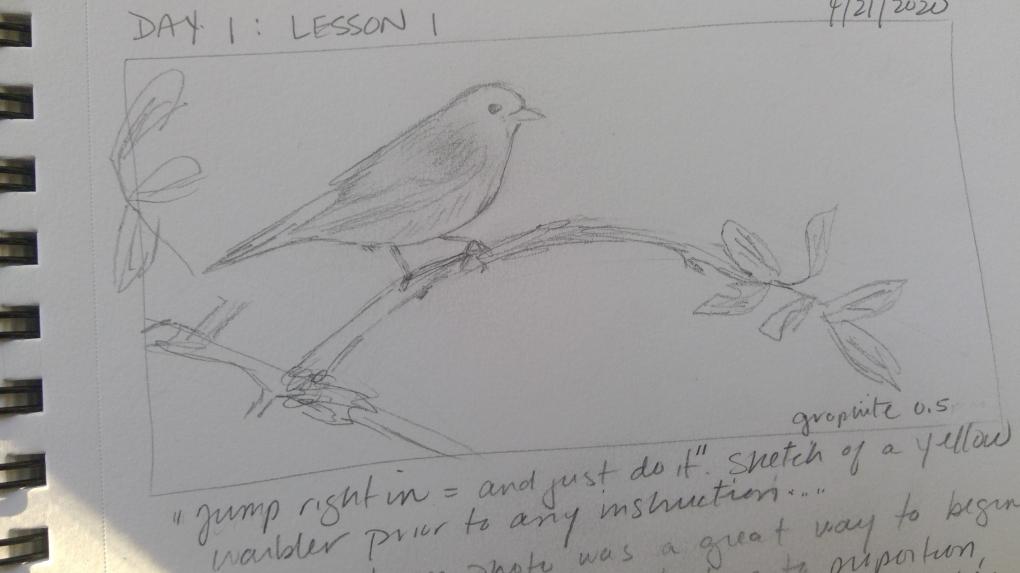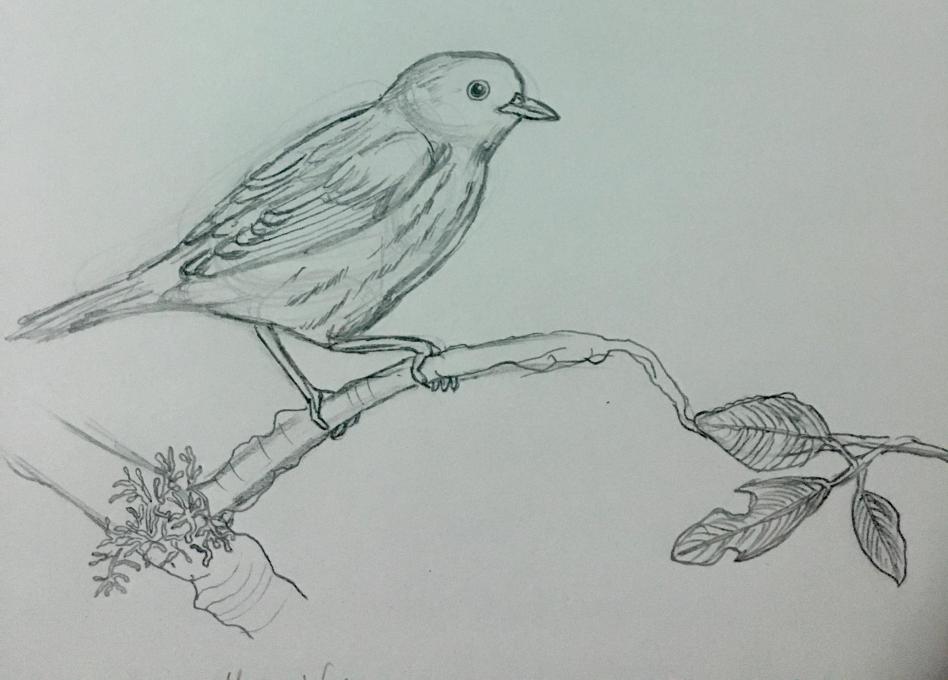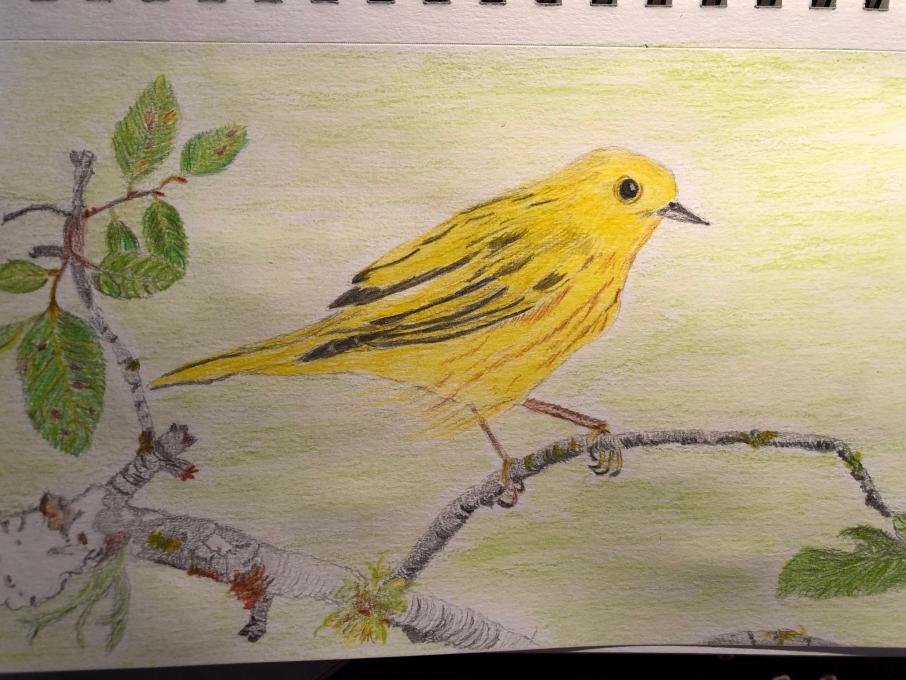The Cornell Lab Bird Academy › Discussion Groups › Nature Journaling and Field Sketching › Jump Right in!
-
-
1) I felt a little apprehensive about it at first, but I loosened up after a little bit. Actually, it didn't turn out as bad as I thought. What came easily was some of the basic shapes, especially the curve of the branch the warbler is sitting on. What was more difficult was the thicker branch toward the bottom of the picture, as well as the bird's stance and trying to make it look accurate. 2) If I weren't asked to draw it, I wouldn't have noticed the bites and marks on of the leaves as well as the way the bird's legs are positioned on the branch. I think this would make a difference when nature journaling since you would loose some valuable detail in your drawings.
-
It was easier to copy the image than attempt to draw from the living bird. I tried drawing the birds coming to the feeder this morning and it was very challenging but the results can be made to work with time and practice. I am 81 years old and would love still to learn to paint. I was going to register in another class but when I saw this offer I decided for my coming birthday to accept the challenge. Francisco.

-
I liked being able to add additional information to images. "Alternate leaves", "Red streaks on yellow", etc. Pencils work well for me and the idea of color and brushes is daunting, and exciting.
![IMG_0291[1300]](data:image/gif;base64,R0lGODlhAQABAAAAACH5BAEKAAEALAAAAAABAAEAAAICTAEAOw==)
-
Hi Michael, I really like the way you labeled the key identifying features of the Yellow Warbler . . . “red streaks on yellow” for its underbelly, for example. It makes the drawing and learning process more interesting and more scientific. Now you’ve motivated me. Thank you!
-
-
I felt somewhat comfortable drawing from a photo because it is stationary and does not move. I was able to look at the lines and angles of branch, leaves and the yellow warbler. Drawing the branch was easier because of the lengths of the lines and being able to see where the leaves were attached to the branch in comparison to the whole branch. The most challenging was the birds feathers. The wing is so like the rest of the body. The chest of the bird was particularly difficult to get the right angle of slope down to the feet. I probably would not have noticed the moss and what looks to be some type of lichen on the branch had I not been trying to draw it. I would think the details would be very difficult to do in nature journaling because there are so many details in nature! Overall, I am I am excited to get started!
-
1. What came easily was the overall image but what was challenging was the colors within the bird and getting those right. Defining the wings were challenging too. 2. I noticed all kinds of things when drawing this warbler -- the wing bars, the faint mark behind the eye, the 2-tone black of the beak, the long legs. I think the advantage of nature journaling is how it generates a sense of wonder and awe.
-
I have not drawn in a while, so I was a bit nervous, but once I started it felt good. The hard part for me are the feathers, especially the very fine, fluffy ones on the upper back. You definitely pay more attention to the details when you have to draw something - especially the color combinations in the feathers. I only drew this with pencil, though, so I could only hit the light and dark tones. But I like that drawing forces you to spend a lot of time on the details, this could really help you remember how to identify a species.

-
You did a great job on the face! Sweet!
-
-

-
I like drawing from a photo because it stays still, but at the same time it lacks the life of a drawing out in nature. Here I can pay attention to details. I liked sketching the beak and feet, something I may not have been able to observe carefully when drawing outside. I wondered about their shape and functions. I found the lychens to be challenging, especially the large one, because it doesn't have the same definitive shape and shading.

-

-
Drawing from a photo is easier than in nature because I have time to compare spaces and angles. I have a lot of trouble with beaks because I haven't practiced enough. I always see things when drawing that I never saw before. Nature journaling makes me much more aware of my surroundings, whether it be a bird or a bee, a person or a tree.

-
What a sweet picture. Love your presentation.
-
-

-
With a still photo, it is easy to focus on the details and perhaps spend more time than one should on a quick sketch. The biggest difficulty I had was in proportions. I could not quite get the sizing right from bird to branch to background. I was not able to show well in my sketch that the warbler's head was turned to the viewer. I do feel like my sketch shows some of the vivacity of the bird and I like that. Drawing is another way of remembering so I hope that in doing so, it will cement some of the field marks for these species in my mind.

-
I prefer drawing from a photo because you have time to study the details. You miss the movement and behaviors, but you can see the light and feather patterns better. It was difficult to represent the shiny bill and the multitude of colors with pencil, but at the same time forced me to pay attention to overall light and contrast of the whole composition. If I drew this again, I'd pay closer attention to the proportions of the breast, head, and eye. They have a flattish crown and a bold brow, which I didn't capture as well as I'd have liked. The eye is too far back from the bill giving him a bit of a woodcock look! Looking forward to learning more techniques and seeing the redo at the end of the course.

-
I enjoyed trying to draw the yellow warbler from the photo and did not feel too embarrassed That my drawing was such a poor image. Everything was a challenge, especially proportions. I didn’t know if I should draw while looking at the image or if I should look at the page while I drew and keep looking back at the photo, alternating. I would not have noticed the details of the foliage or the shading on the wings. Details like these hone my sense of sight and memory for journaling.
-

-
As a photo, I would notice the details only in broad strokes...yellow bird, green leaves, stick. Drawing it caused me to take note of many details about the bird, the shape of and the light on the leaves, shape of the branch, the lichen and the moss on the stick...even though not detailed in my drawing.
-

-
Yours is my favorite drawing of the Yellow Warbler. I like the way you were able to create dimension on the bird by showing us the tip of its left wing. And on the branches and leaves with shading and leaf positioning. I’ll keep following your drawings, because I know good things are coming!
-
-
Oh boy. For me this was challenging even capturing the larger gestures and my poor warbler looks like a zombie. I haven't worked with watercolors much at all so I opted out. But I can see that spending a little more time with the context will help. It's very "sketchy" and like one of the other students I always start lightly in pencil but often fail to go in and darken where it needs darkening. I also need to spend more time when I can. I get frustrated when my proportions and relationships seem off - sometimes its a matter of playing with that lineweight a bit. I was fascinated by how the warbler's feet gripped the branch and could study the foot - thank goodness it was a photo!

-
Drawing was, interestingly, the easy part. I just completed a beginning drawing two-day class at my local arts non-profit's studio, so I rendered it first in graphite. However, using watercolors never, it was another interesting process capturing the details of what I had drawn from the photo. This presketch/watercolor is not finished, obviously, but now I definitely know exactly what I don't know. It was all sort of meditative and I am very much looking forward to the rest of this course during which I anticipate learning techniques that advance me from an aspiring Audubon or RTPeterson wannabe to a status closer to apprentice.

-
For me, the easiest part was to respect the proportions, I thought it would have been more difficult. The biggest challenge was the wing with all the thin lines. To represent the different textures in the feathers is not easy. I noticed so many details during the process! For exemple how the wing is built in layers and the very subtle circle around the eye. After completing my first drawing, which took me long, I tried to do it a second time now sketching it in two minutes or so.


-
Hello Liz, here is my drawing. I really liked the picture of this cute bird and enjoyed drawing it. I don't know how to render the shades and the form of the feathers, and I would like to learn how to go from a simple sketch to an actual drawing. Thank you for your nice videos.

-
Laura, I like your bird's stance and the glint in the eye. Nicely done. Enjoy the class and take your time and savor each activity. That is what I am doing...I want it to last forever so I take time to practice and do many examples for each lesson before moving forward as the class is self-paced. Just wanted to take a moment to welcome and encourage you as you move fwd through the class. Happy Nature Journaling and Field Sketching through your days.
-
-
Off and running! So glad to finally be putting pencil to paper and giving this a try. I liked sketching with a still photo so I could take my time and really focus on trying to get the proportions right - still have some work to do on that, but not horrified by my first effort. The heavy paper and graphite pencil were so easy to work with. I think I'm going to like this!

-

-
The hardest part of drawing is getting the proportions and scales correct. I struggled with the wings and the main branch of the tree.
-
-
Drawing from the photo gave me time to notice details and attempt to get them in my drawing. I do wonder about working with live subjects! Plants will stay put, mostly, but light will change. Critters, if I ask kindly, will they stay put just a little longer? Guess not... It seems that for now, if I want to really capture details, I may need to work from photos. Getting the drawing down with pencil was easier than I thought it would be. Paying attention to the detail in the bird was easy. I loved the close observation work. I think I wouldn't have noticed the close details in the plant if I were focusing on the bird while working outside. And if working outside, I don't think I would have as much detail in the bird. I'd have been making text notes to come back to fill in details in the drawing later. Thank you for sharing your photos and comments. We do learn more when we share our experiences.

-
Really love this!
-
Read More:
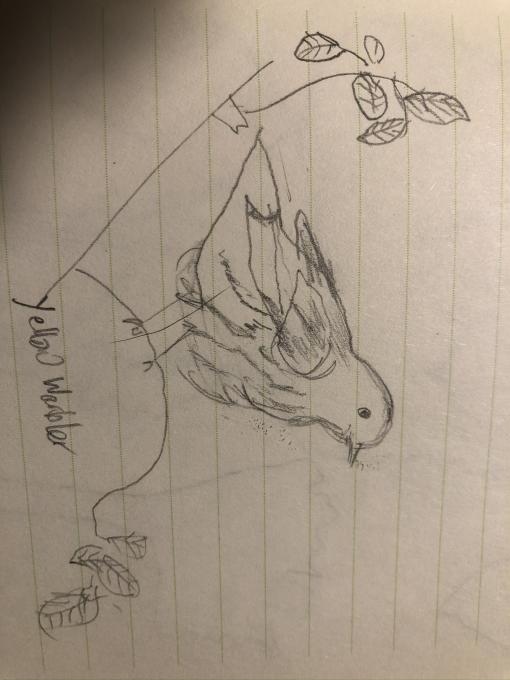
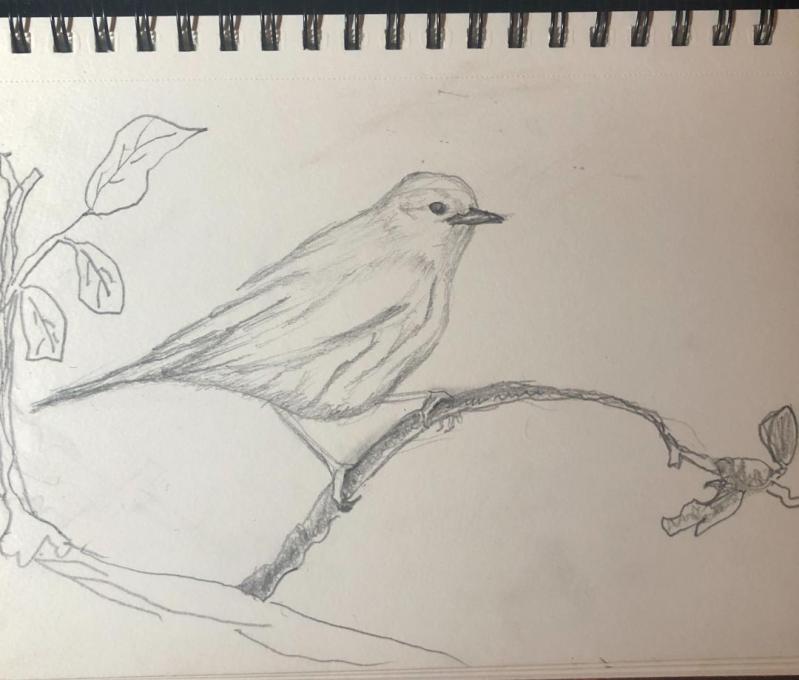
![IMG_0291[1300]](https://academy.allaboutbirds.org/wp-content/uploads/hm_bbpui/695226/50ism7qfnyh2ltkxj9ys1qlaude1qnn0.jpg)
